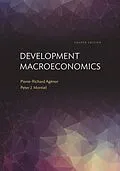The global financial crisis triggered severe shocks for developing countries, whose embrace of greater commercial and financial openness has increased their exposure to external shocks, both real and financial. This new edition of Development Macroeconomics has been fully revised to address the more open and less stable environment in which developing countries operate today. Describing the latest advances in this rapidly changing field, the book features expanded coverage of public debt and the management of capital inflows as well as new material on fiscal discipline, monetary policy regimes, currency, banking and sovereign debt crises, currency unions, and the choice of an exchange-rate regime. A new chapter on dynamic stochastic general equilibrium (DSGE) models with financial frictions has been added to reflect how the financial crisis has reshaped our thinking on the role of such frictions in generating and propagating real and financial shocks. The book also discusses the role of macroprudential regulation, both independently and through its interactions with monetary policy, in preserving financial and macroeconomic stability. Now in its fourth edition, Development Macroeconomics remains the definitive textbook on the macroeconomics of developing countries.
- The most authoritative book on the subject-now fully revised and expanded
- Features new material on fiscal discipline, monetary policy regimes, currency, banking and sovereign debt crises, and much more
- Comes with online supplements on informal financial markets, stabilization programs, the solution of DSGE models with financial frictions, and exchange rate crises
Autorentext
Pierre-Richard Agénor is the Hallsworth Professor of International Macroeconomics and Development Economics at the University of Manchester. Peter J. Montiel is the Fairleigh S. Dickinson Jr. '41 Professor of Economics at Williams College.
Inhalt
- Frontmatter, pg. i
- Contents, pg. vii
- Preface to the Fourth Edition, pg. xix
- Introduction and Overview, pg. 1
- Chapter 1. Economic Structure and Aggregate Accounts, pg. 12
- Chapter 2. Behavioral Functions, pg. 52
- Chapter 3. The Government Budget and Fiscal Management, pg. 78
- Chapter 4. Macroeconomic Effects of Fiscal Policy, pg. 109
- Chapter 5. Financial Markets and the Monetary Transmission Mechanism, pg. 144
- Chapter 6. A Framework for Monetary Policy Analysis, pg. 182
- Chapter 7. Inflation Targeting, Macroeconomic Stability, and Financial Stability, pg. 224
- Chapter 8. Choosing an Exchange-Rate Regime I: Credibility, Flexibility, and Welfare, pg. 262
- Chapter 9. Choosing an Exchange-Rate Regime II: The Role of Shocks, Contractionary Effects, and Moral Hazard, pg. 295
- Chapter 10. Inflation and Short-Run Dynamics, pg. 331
- Chapter 11. Analytical Issues in Disinflation Programs, pg. 381
- Chapter 12. Dynamic Stochastic Equilibrium Models with Financial Frictions, pg. 441
- Chapter 13. Financial Integration and Capital Flows, pg. 476
- Chapter 14. Exchange-Rate Crises and Sudden Stops, pg. 514
- Chapter 15. Banking Crises and Twin Crises, pg. 550
- Chapter 16. Sovereign Debt Crises, pg. 572
- Chapter 17. Macroeconomic Policies and Growth, pg. 602
- Chapter 18. Trade Liberalization, Financial-Sector Reforms, and Sequencing, pg. 640
- Chapter 19. The Political Economy of Adjustment, pg. 675
- Epilogue, pg. 697
- References, pg. 701
- Index of Names, pg. 741
- Index of Subjects, pg. 751
